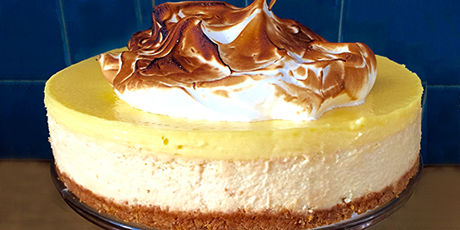
Meyer lemons are a cross between a regular lemon and a tangerine, so they have a more floral aroma and slightly sweeter taste than regular lemons. They are typically available all spring, but you can always use regular lemons for this recipe.
This cheesecake has an unbelievably creamy filling that won’t crack when you bake it, and then it is topped with a lemon curd, followed by a meringue topping. If you want to save a few steps, you can skip the curd and/or meringue – the cheesecake on it’s own is stupendous.
ingredients
Graham Crust
Cheesecake
Lemon Curd
Meringue Topping
directions
Preheat the oven to 350 ºF (180 ºC). Lightly grease a 9-inch (23 cm) springform pan.
For the crust, stir the graham crumbs, sugar and melted butter together in a bowl until combined and press this into the bottom of the prepared pan. Bake for 10 minutes (no change in colour to note) and cool completely on a rack before filling.
For the cheesecake, lower the oven temperature to 300 ºF (150 ºC). Beat the cream cheese until light and fluffy. Beat in the condensed milk, scraping the sides and bottom of the bowl well. Beat in the zest and vanilla, then on a lower speed; beat in each egg and the yolk one at a time. Still on low speed, beat in the lemon juice. Pour this over the cooled crust and bake for about 45 minutes, until the outside of the cheesecake is set, but the centre still has a little jiggle to it. Prepare the lemon curd as the cheesecake cools.
For the curd, whisk the whole eggs, egg yolks, sugar, lemon zest and juice in a metal bowl. Whisk in the butter and sour cream and place the bowl over a pot of gently simmering water, whisking often, until the lemon curd has thickened (but it will still be fluid), about 10 minutes. Strain the curd and spread this gently over the cheesecake. Once fully cooled to room temperature, chill the cheesecake for at least 6 hours (do not cover with plastic wrap).
For the topping, whisk the egg whites and sugar in a metal bowl placed over a pot of gently simmering water until frothy and very warm to touch (165 F if using a thermometer). Use electric beaters or transfer to the bowl of a stand mixer and whip until the meringue has cooled and holds a stiff peak when the beaters are lifted. Use a butane kitchen torch to brown the meringue or pop it into a 400 ºF (200 ºC) oven for 3-4 minutes to brown and then cool before refrigerating.
